

Compact Muon Solenoid
LHC, CERN
| CMS-HIN-20-002 ; CERN-EP-2023-294 | ||
| Elliptic anisotropy measurement of the f$_0$(980) hadron in proton-lead collisions and evidence for its quark-antiquark composition | ||
| CMS Collaboration | ||
| 28 December 2023 | ||
| Nature Commun. 16 (2025) 1, 7990 | ||
| Abstract: Despite the f$_0$(980) hadron having been discovered half a century ago, the question about its quark content has not been settled: it might be an ordinary quark-antiquark ($ \mathrm{q}\overline{\mathrm{q}} $) meson, a tetraquark ($ \mathrm{q}\overline{\mathrm{q}}\mathrm{q}\overline{\mathrm{q}} $) exotic state, a kaon-antikaon ($ \mathrm{K}\overline{\mathrm{K}} $) molecule, or a quark-antiquark-gluon ($ \mathrm{q}\overline{\mathrm{q}}\mathrm{g} $) hybrid. This paper reports strong evidence that the f$_0$(980) state is an ordinary $ \mathrm{q}\overline{\mathrm{q}} $ meson, inferred from the scaling of elliptic anisotropies ($ v_{2} $) with the number of constituent quarks ($ n_{\mathrm{q}} $), as empirically established using conventional hadrons in relativistic heavy ion collisions. The f$_0$(980) state is reconstructed via its dominant decay channel $ \mathrm{f}_0(980) \to \pi^{+}\pi^{-} $, in proton-lead collisions recorded by the CMS experiment at the LHC, and its $ v_{2} $ is measured as a function of transverse momentum ($ p_{\mathrm{T}} $). It is found that the $ n_{\mathrm{q}} = $ 2 ($ \mathrm{q}\overline{\mathrm{q}} $ state) hypothesis is favored over $ n_{\mathrm{q}} = $ 4 ($ \mathrm{q} \overline{\mathrm{q}} \mathrm{q} \overline{\mathrm{q}} $ or $ \mathrm{K}\overline{\mathrm{K}} $ states) by 7.7, 6.3, or 3.1 standard deviations in the $ p_{\mathrm{T}} < $ 10, 8, or 6 GeV/$c$ ranges, respectively, and over $ n_{\mathrm{q}}= $ 3 ($ \mathrm{q}\overline{\mathrm{q}}\mathrm{g} $ hybrid state) by 3.5 standard deviations in the $ p_{\mathrm{T}} < $ 8 GeV/$c$range. This result represents the first determination of the quark content of the f$_0$(980) state, made possible by using a novel approach, and paves the way for similar studies of other exotic hadron candidates. | ||
| Links: e-print arXiv:2312.17092 [hep-ex] (PDF) ; CDS record ; inSPIRE record ; HepData record ; CADI line (restricted) ; | ||
| Figures | |

png pdf |
Figure 1:
Coalescence hadronization. This picture illustrates the formation of hadrons in heavy ion collisions in the coalescence model. Hadrons tend to form when the constituent quarks have similar positions and momenta. [Detector image reprinted from [43], under a \hrefhttps://creativecommons.org/licenses/by-sa/4.0/CC BY SA 4.0 license.] |
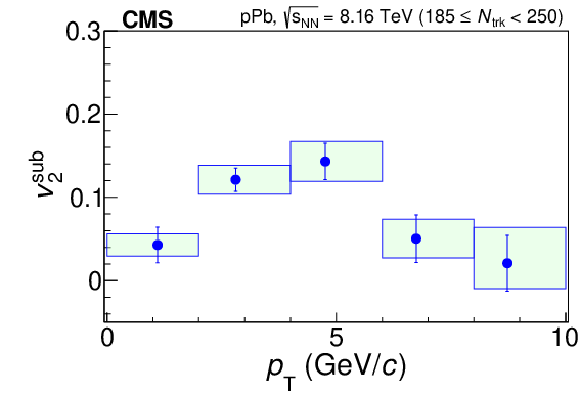
png pdf |
Figure 2:
Elliptic anisotropy results. The nonflow-effect-subtracted elliptic anisotropy $ v_2^{\text{sub}} $ of the f$_0$(980) is shown as a function of $ p_{\mathrm{T}} $ within $ |y| \lesssim $ 2.4 in high-multiplicity pPb collisions. The error bars show statistical uncertainties while the shaded areas represent systematic uncertainties. |
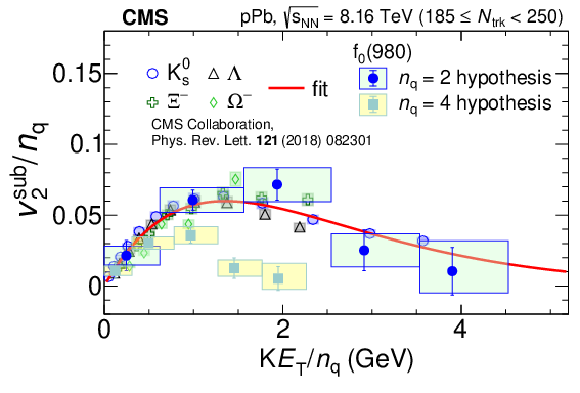
png pdf |
Figure 3:
NCQ scaling of elliptic anisotropy. The $ v_2^{\text{sub}}/n_{\mathrm{q}} $ of the f$_0$(980) state (for the $ n_{\mathrm{q}}= $ 2 and 4 hypotheses) as a function of $ KE_{\text T}/n_{\mathrm{q}} $, compared with those of $ \mathrm{K^0_S} $, $ \Lambda $, $ \Xi^{-} $, and $ \Omega $ strange hadrons [53] in high-multiplicity pPb collisions. The error bars show statistical uncertainties while the shaded areas represent systematic uncertainties. The red curve is the NCQ scaling parameterization of the data for $ \mathrm{K^0_S} $, $ \Lambda $, $ \Xi^{-} $, and $ \Omega $ hadrons given by Eq. (2). |
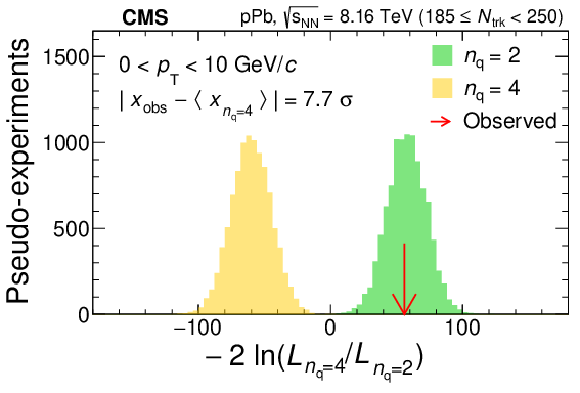
png pdf |
Figure 4:
Exclusion significance from $ n_{\mathrm{q}}= $ 4. The log-likelihood ratio distributions for the $ n_{\mathrm{q}}= $ 2 and 4 hypotheses from pseudo-experiments, together with the measured value for the f$_0$(980) state in the 0 $ < p_{\mathrm{T}} < 10 GeV/$c$range. |
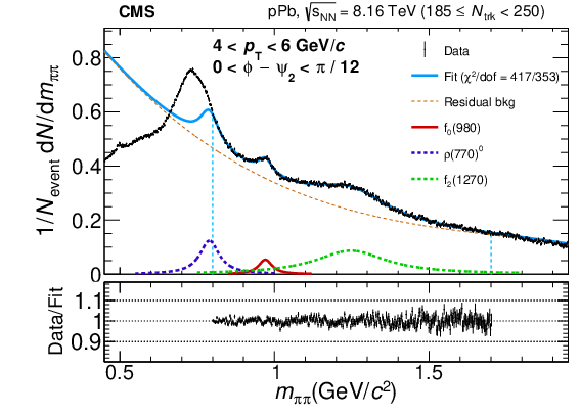
png pdf |
Figure 5:
Invariant mass fit. The invariant mass spectrum of opposite-sign pion pairs after the combinatorial background subtraction, for the pair transverse momentum 4 $ < p_{\mathrm{T}} < $ 6 GeV/$c$and the azimuthal angle 0 $ < \phi-\psi_{2} < \pi/ $12, in high-multiplicity pPb collisions. The solid blue curve is the fit result within the fit range marked with vertical blue dashed lines; the orange dashed curve represents the residual background. The solid red curve represents the f$_0$(980) signal, while the dashed dark-violet and light-green curves correspond to the background contributions from the $ \rho$(770)$^0 $ and f$_2$(1270) resonances, respectively. The ratio between data and the fit result is shown in the lower panel, with the error bars representing statistical uncertainties only. The low-mass region exhibits a nontrivial turn-on behavior and is not included in the fit. |

png pdf |
Figure 6:
Elliptic anisotropy before the nonflow effect subtraction. a: The f$_0$(980) yield in the 4 $ < p_{\mathrm{T}} < $ 6 GeV/$c$range as a function of $ \phi-\psi_{2} $ in high-multiplicity pPb collisions. Error bars show statistical uncertainties. The red curve is a fit to Eq. (1) with only the $ n= $ 2 term, from which the elliptic anisotropy $ v_{2} $ parameter is extracted. b: The elliptic anisotropy $ v_{2} $ of the f$_0$(980) state is shown before the nonflow effect subtraction as a function of $ p_{\mathrm{T}} $ within rapidity $ |y| \lesssim $ 2.4 in high-multiplicity pPb collisions. The error bars show statistical uncertainties while the shaded areas represent systematic uncertainties. |
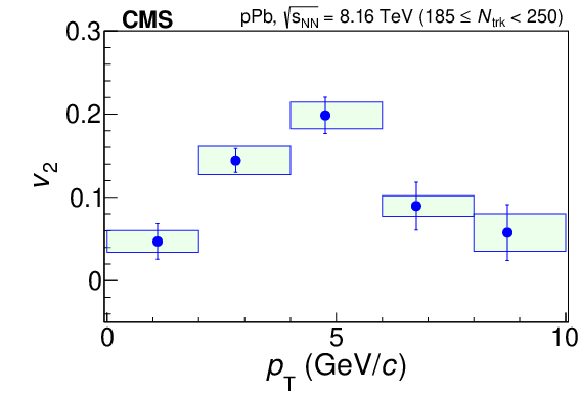
png pdf |
Figure 7:
NCQ scaling of elliptic anisotropy in $ p_{\mathrm{T}}/n_{\mathrm{q}} $. The $ v_2^{\text{sub}}/n_{\mathrm{q}} $ of the f$_0$(980) state (for the $ n_{\mathrm{q}}= $ 2 and 4 hypotheses) as a function of $ p_{\mathrm{T}}/n_{\mathrm{q}} $ is compared with those of the $ \mathrm{K^0_S} $, $ \Lambda $, $ \Xi^{-} $, and $ \Omega $ strange hadrons \protect [53] in high-multiplicity pPb collisions. Error bars show the statistical uncertainties while the shaded areas represent systematic uncertainties. The red curve is the NCQ scaling parameterization of the data for the $ \mathrm{K^0_S} $, $ \Lambda $, $ \Xi^{-} $, and $ \Omega $ hadrons. |
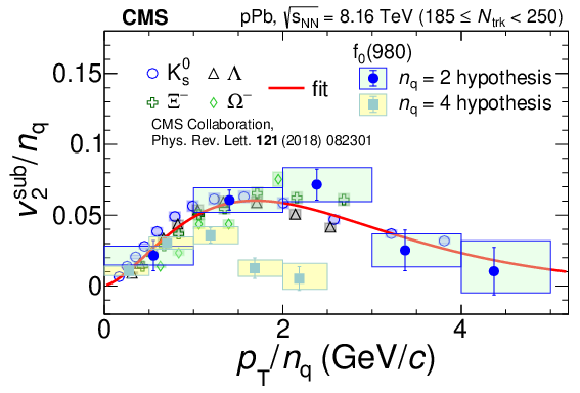
png pdf |
Figure 8:
{The $ \chi^2 $ scan.} The $ \chi^2 $ of the f$_0$(980) elliptic flow data with respect to the NCQ scaling parameterization, scanned in steps of $ n_\mathrm{q} $. The three curves correspond to using f$_0$(980) data for $ p_{\mathrm{T}} < $ 6, 8, and 10 GeV/$c$, respectively. |
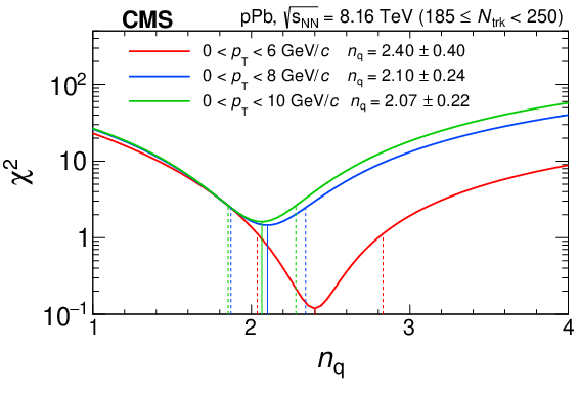
png pdf |
Figure 9:
Exclusion significances. a, b: same as Fig. 4 but using f$_0$(980) $v_2^{\text{sub}} $ data within the restricted ranges $ p_{\mathrm{T}} < $ 8 GeV/$c$ (a) and $ p_{\mathrm{T}} < $ 6 GeV/$c$ (b). c: The expected log-likelihood ratio distributions for $ n_{\mathrm{q}}= $ 2 vs. 3 hypotheses from the pseudo-experiments and the observed value for the f$_0$(980) in data in the $ p_{\mathrm{T}} < $ 8 GeV/$c$range to extract the exclusion significance for $ n_{\mathrm{q}}= $ 3. |
| Tables | |
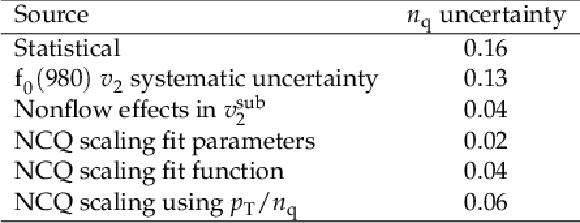
png pdf |
Table 1:
Sources and magnitudes of the uncertainties in the extracted $ n_{\mathrm{q}} $ of the f$_0$(980) state in the range $ p_{\mathrm{T}} < $ 10 GeV/$c$. |
| Summary |
| References | ||||
| 1 | M. Gell-Mann | A schematic model of baryons and mesons | PL 8 (1964) 214 | |
| 2 | G. Zweig | An SU$ _3 $ model for strong interaction symmetry and its breaking; Version 2 | Developments in the Quark Theory of Hadrons. Vol. 1. --1978, 1964 link |
|
| 3 | R. L. Jaffe | Perhaps a stable dihyperon | PRL 38 (1977) 195 | |
| 4 | R. L. Jaffe | Exotica | Phys. Rept. 409 (2005) 1 | hep-ph/0409065 |
| 5 | R. A. Briceno, J. J. Dudek, R. G. Edwards, and D. J. Wilson | Isoscalar $ \pi\pi, K\overline{K}, \eta\eta $ scattering and the $ \sigma, f_0, f_2 $ mesons from QCD | PRD 97 (2018) 054513 | 1708.06667 |
| 6 | Belle Collaboration | Observation of a narrow charmonium-like state in exclusive $ B^\pm \to K^\pm \pi^+ \pi^- J/\psi $ decays | PRL 91 (2003) 262001 | hep-ex/0309032 |
| 7 | LHCb Collaboration | Observation of an exotic narrow doubly charmed tetraquark | Nature Phys. 18 (2022) 751 | 2109.01038 |
| 8 | A. Esposito, A. Pilloni, and A. D. Polosa | Multiquark resonances | Phys. Rept. 668 (2017) 1 | 1611.07920 |
| 9 | S. L. Olsen, T. Skwarnicki, and D. Zieminska | Nonstandard heavy mesons and baryons: experimental evidence | Rev. Mod. Phys. 90 (2018) 015003 | 1708.04012 |
| 10 | S. D. Protopopescu et al. | $ \pi\pi $ partial wave analysis from reactions $ \pi^+ p \to \pi^+ \pi^- \Delta^{++} $ and $ \pi^+ p \to K^+ K^- \Delta^{++} $ at 7.1 GeVc | PRD 7 (1973) 1279 | |
| 11 | B. Hyams et al. | $ \pi\pi $ phase shift analysis from 600 to 1900 MeV | NPB 64 (1973) 134 | |
| 12 | G. Grayer et al. | High statistics study of the reaction $ \pi^- p \to \pi^-\pi^+ n $: apparatus, method of analysis, and general features of results at 17 GeVc | NPB 75 (1974) 189 | |
| 13 | R. L. Jaffe | Multi-quark hadrons. 1. phenomenology of ($ Q^2{\bar Q}^2 $) mesons | PRD 15 (1977) 267 | |
| 14 | J. D. Weinstein and N. Isgur | $ \mathrm{K}\overline{\mathrm{K}} $ molecules | PRD 41 (1990) 2236 | |
| 15 | C. Amsler and N. A. Tornqvist | Mesons beyond the naive quark model | Phys. Rept. 389 (2004) 61 | |
| 16 | D. V. Bugg | Four sorts of meson | Phys. Rept. 397 (2004) 257 | hep-ex/0412045 |
| 17 | E. Klempt and A. Zaitsev | Glueballs, hybrids, multiquarks. experimental facts versus QCD inspired concepts | Phys. Rept. 454 (2007) 1 | 0708.4016 |
| 18 | A. Deandrea et al. | The $ \mathrm{s}\overline{\mathrm{s}} $ and $ \mathrm{K}\overline{\mathrm{K}} $ nature of f$_{0}$(980) in $ \mathrm{D}_{s} $ decays | PLB 502 (2001) 79 | hep-ph/0012120 |
| 19 | Particle Data Group , S. Navas et al. | Review of particle physics | PRD 110 (2024) 030001 | |
| 20 | CMS Collaboration | Evidence for \HepParticleResonanceX3872 in Pb-Pb collisions and studies of its prompt production at $ \sqrt{\smash[b]{s_{_{\mathrm{NN}}}}}= $ 5.02 TeV | PRL 128 (2022) 032001 | CMS-HIN-19-005 2102.13048 |
| 21 | S. T. Butler and C. A. Pearson | Deuterons from high-energy proton bombardment of matter | PR 129 (1963) 836 | |
| 22 | C. B. Dover, U. W. Heinz, E. Schnedermann, and J. Zimanyi | Relativistic coalescence model for high-energy nuclear collisions | Phys. Rev. C 44 (1991) 1636 | |
| 23 | R. J. Fries, V. Greco, and P. Sorensen | Coalescence models for hadron formation from quark gluon plasma | Ann. Rev. Nucl. Part. Sci. 58 (2008) 177 | 0807.4939 |
| 24 | R. C. Hwa and C. B. Yang | Scaling behavior at high $ p_{\mathrm{T}} $ and the p/$ \pi $ ratio | Phys. Rev. C 67 (2003) 034902 | nucl-th/0211010 |
| 25 | R. J. Fries, B. Muller, C. Nonaka, and S. A. Bass | Hadronization in heavy ion collisions: recombination and fragmentation of partons | PRL 90 (2003) 202303 | nucl-th/0301087 |
| 26 | V. Greco, C. M. Ko, and P. Levai | Parton coalescence and the antiproton/pion anomaly at RHIC | PRL 90 (2003) 202302 | nucl-th/0301093 |
| 27 | J.-Y. Ollitrault | Anisotropy as a signature of transverse collective flow | PRD 46 (1992) 229 | |
| 28 | PHOBOS Collaboration | Importance of correlations and fluctuations on the initial source eccentricity in high-energy nucleus-nucleus collisions | Phys. Rev. C 77 (2008) 014906 | 0711.3724 |
| 29 | CMS Collaboration | Observation of long-range near-side angular correlations in proton-proton collisions at the LHC | JHEP 09 (2010) 091 | CMS-QCD-10-002 1009.4122 |
| 30 | ATLAS Collaboration | Observation of long-range elliptic azimuthal anisotropies in $ \sqrt{s}= $ 13 and 2.76 TeV pp collisions with the ATLAS detector | PRL 116 (2016) 172301 | 1509.04776 |
| 31 | CMS Collaboration | Measurement of long-range near-side two-particle angular correlations in pp collisions at $ \sqrt{s} = $ 13 TeV | PRL 116 (2016) 172302 | CMS-FSQ-15-002 1510.03068 |
| 32 | CMS Collaboration | Evidence for collectivity in pp collisions at the LHC | PLB 765 (2017) 193 | CMS-HIN-16-010 1606.06198 |
| 33 | CMS Collaboration | Observation of long-range near-side angular correlations in proton-lead collisions at the LHC | PLB 718 (2013) 795 | CMS-HIN-12-015 1210.5482 |
| 34 | ALICE Collaboration | Long-range angular correlations on the near and away side in p--Pb collisions at $ \sqrt{\smash[b]{s_{_{\mathrm{NN}}}}}= $ 5.02 TeV | PLB 719 (2013) 29 | 1212.2001 |
| 35 | ATLAS Collaboration | Observation of associated near-side and away-side long-range correlations in $ \sqrt{\smash[b]{s_{_{\mathrm{NN}}}}}= $ 5.02 TeV proton-lead collisions with the ATLAS detector | PRL 110 (2013) 182302 | 1212.5198 |
| 36 | CMS Collaboration | Multiplicity and transverse momentum dependence of two- and four-particle correlations in $ \mathrm{p}\mathrm{Pb} $ and PbPb collisions | PLB 724 (2013) 213 | CMS-HIN-13-002 1305.0609 |
| 37 | ATLAS Collaboration | Measurement of long-range pseudorapidity correlations and azimuthal harmonics in $ \sqrt{\smash[b]{s_{_{\mathrm{NN}}}}}= $ 5.02 TeV proton-lead collisions with the ATLAS detector | Phys. Rev. C 90 (2014) 044906 | 1409.1792 |
| 38 | CMS Collaboration | Long-range two-particle correlations of strange hadrons with charged particles in $ \mathrm{p}\mathrm{Pb} $ and PbPb collisions at LHC energies | PLB 742 (2015) 200 | CMS-HIN-14-002 1409.3392 |
| 39 | CMS Collaboration | Evidence for collective multiparticle correlations in $ \mathrm{p}\mathrm{Pb} $ collisions | PRL 115 (2015) 012301 | CMS-HIN-14-006 1502.05382 |
| 40 | LHCb Collaboration | Measurements of long-range near-side angular correlations in $ \sqrt{\smash[b]{s_{_{\mathrm{NN}}}}}= $ 5 TeV proton-lead collisions in the forward region | PLB 762 (2016) 473 | 1512.00439 |
| 41 | A. Gu, T. Edmonds, J. Zhao, and F. Wang | Elliptical flow coalescence to identify the f$_{0}$(980) content | Phys. Rev. C 101 (2020) 024908 | 1902.07152 |
| 42 | A. M. Poskanzer and S. A. Voloshin | Methods for analyzing anisotropic flow in relativistic nuclear collisions | Phys. Rev. C 58 (1998) 1671 | nucl-ex/9805001 |
| 43 | T. Sakuma and T. McCauley, for the CMS Collaboration | Detector and Event Visualization with SketchUp at the CMS Experiment | link | |
| 44 | D. Molnar and S. A. Voloshin | Elliptic flow at large transverse momenta from quark coalescence | PRL 91 (2003) 092301 | nucl-th/0302014 |
| 45 | L. Maiani, A. D. Polosa, V. Riquer, and C. A. Salgado | Counting valence quarks at RHIC and LHC | PLB 645 (2007) 138 | hep-ph/0606217 |
| 46 | ExHIC Collaboration | Multi-quark hadrons from heavy ion collisions | PRL 106 (2011) 212001 | 1011.0852 |
| 47 | A. Gu and F. Wang | Transverse momentum spectra of f$_{0}$(980) from coalescence model | PLB 848 (2024) 138399 | 2306.08584 |
| 48 | ALICE Collaboration | Observation of abnormal suppression of f$_{0}$(980) production in p--Pb collisions at $ \sqrt{\smash[b]{s_{_{\mathrm{NN}}}}} = $ 5.02 TeV | PLB 853 (2024) 138665 | 2311.11786 |
| 49 | STAR Collaboration | Particle type dependence of azimuthal anisotropy and nuclear modification of particle production in Au + Au collisions at $ \sqrt{\smash[b]{s_{_{\mathrm{NN}}}}} = $ 200 GeV | PRL 92 (2004) 052302 | nucl-ex/0306007 |
| 50 | PHENIX Collaboration | Scaling properties of azimuthal anisotropy in Au+Au and Cu+Cu collisions at $ \sqrt{\smash[b]{s_{_{\mathrm{NN}}}}} = $ 200 GeV | PRL 98 (2007) 162301 | nucl-ex/0608033 |
| 51 | ALICE Collaboration | Elliptic flow of identified hadrons in Pb-Pb collisions at $ \sqrt{\smash[b]{s_{_{\mathrm{NN}}}}}= $ 2.76 TeV | JHEP 06 (2015) 190 | 1405.4632 |
| 52 | ALICE Collaboration | Anisotropic flow of identified particles in Pb-Pb collisions at $ \sqrt{\smash[b]{s_{_{\mathrm{NN}}}}}= $ 5.02 TeV | JHEP 09 (2018) 006 | 1805.04390 |
| 53 | CMS Collaboration | Elliptic flow of charm and strange hadrons in high-multiplicity $ \mathrm{p}\mathrm{Pb} $ collisions at $ \sqrt{\smash[b]{s_{_{\mathrm{NN}}}}} = $ 8.16 TeV | PRL 121 (2018) 082301 | CMS-HIN-17-003 1804.09767 |
| 54 | CMS Collaboration | HEPData record for this analysis | link | |
| 55 | CMS Collaboration | The CMS trigger system | JINST 12 (2017) P01020 | CMS-TRG-12-001 1609.02366 |
| 56 | CMS Collaboration | Observation of correlated azimuthal anisotropy Fourier harmonics in $ pp $ and $ p+Pb $ collisions at the LHC | PRL 120 (2018) 092301 | CMS-HIN-16-022 1709.09189 |
| 57 | V. Weisskopf and E. P. Wigner | Berechnung der naturlichen linienbreite auf grund der Diracschen lichttheorie | Z. Phys. 63 (1930) 54 | |
| 58 | M. H. Hull and G. Breit | Coulomb wave functions | Springer Berlin Heidelberg, Berlin, Heidelberg, 1959 link |
|
| 59 | STAR Collaboration | $ \rho^0 $ production and possible modification in Au+Au and p+p collisions at $ \sqrt{\smash[b]{s_{_{\mathrm{NN}}}}} = $ 200 GeV | PRL 92 (2004) 092301 | nucl-ex/0307023 |
| 60 | STAR Collaboration | NCQ scaling of f$_{0}$(980) elliptic flow in 200 GeV Au+Au collisions by STAR and its constituent quark content | Eur. Phys. J. Web Conf. 259 (2022) 10013 | 2202.01618 |
| 61 | CMS Collaboration | Description and performance of track and primary-vertex reconstruction with the CMS tracker | JINST 9 (2014) P10009 | CMS-TRK-11-001 1405.6569 |
| 62 | CMS Collaboration | Strategies and performance of the CMS silicon tracker alignment during LHC Run 2 | NIM A 1037 (2022) 166795 | CMS-TRK-20-001 2111.08757 |
| 63 | CMS Collaboration | Performance of the CMS Level-1 trigger in proton-proton collisions at $ \sqrt{s} = $ 13 TeV | JINST 15 (2020) P10017 | CMS-TRG-17-001 2006.10165 |
| 64 | CMS Collaboration | The CMS experiment at the CERN LHC | JINST 3 (2008) S08004 | |
| 65 | CMS Collaboration | Development of the CMS detector for the CERN LHC Run 3 | JINST 19 (2024) P05064 | CMS-PRF-21-001 2309.05466 |
| 66 | M. Gyulassy and X.-N. Wang | HIJING 1.0: A Monte Carlo program for parton and particle production in high-energy hadronic and nuclear collisions | Comput. Phys. Commun. 83 (1994) 307 | nucl-th/9502021 |
| 67 | GEANT4 Collaboration | GEANT 4---a simulation toolkit | NIM A 506 (2003) 250 | |
| 68 | P. T. Matthews and A. Salam | Relativistic theory of unstable particles. II | PR 115 (1959) 1079 | |
| 69 | R. A. Kycia and S. Jadach | Relativistic Voigt profile for unstable particles in high energy physics | J. Math. Anal. Appl. 463 (2018) 1040 | 1711.09304 |

|
Compact Muon Solenoid LHC, CERN |

|

|

|

|

|

|